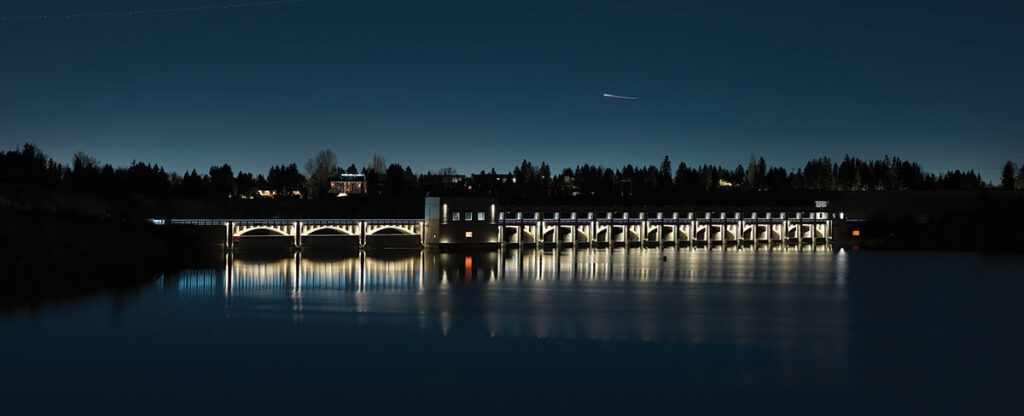A renewal of the Glenmore Dam provides more than just electrical power and safety for residentsBy Michele Zimmerman
Photo: ryanhk.com
In 2017—four years after a disastrous flood on the Elbow River in the city of Calgary in Alberta, Canada forced the evacuation of thousands of residents and caused approximately $6 billion in financial losses—the $82 million Glenmore Dam renewal project commenced. Recognized with a 2022 IES Illumination Award of Merit, the renovation now includes structural enhancements, an homage to the original architecture, the addition of steel floodgates, an expansion of pedestrian pathways, and an upper tech-deck with a mechanized hoist system. The lighting design for this infrastructure project by SMP Engineering is as much about showcasing the updated architecture through hidden elements of illumination, as it is about operational requirements and pedestrian safety.
Before the renovation, the dam on the Glenmore Reservoir was only a place people interacted with “as long as they needed to cross it,” says Ian Martens, lead designer. “It wasn’t a destination. Half the bridge deck was covered by a water pipe that was joined by electrical conduit.” Now, the dam supplies the community with more than just a source of electrical power: it provides a visually enticing area for residents to enjoy. “The second time I was there with my wife and daughter, there were two families that met there to play at night. It was such a huge compliment to see the community using it—to see how well it fits in the larger world,” says Martens.
Designers took a layered approach to the lighting scheme, beginning with highlights to the heritage architecture elements, along with a combination of cool and warm tones to play up the texture of the sandstone and concrete construction materials. The handrails and balustrades, for example, are exact replicas of the originals. Embedded in the handrails are 5000K flexible linear neon lights (American Lighting), continuously run with rubber bushings placed in between sections of concrete. Designers intentionally chose a product easy to cut and replace should the handrail lights fail. The next layer in the scheme, is the cool light from the handrails that “bounces off the bridge deck to illuminate pedestrians from below,” says Martens.
In addition, warm 3000K TROV lights by Ecosense were installed to help pedestrians safely navigate the pathway. “We introduced a couple different colors because it provides a sense of dynamism and interest,” says Martens. The lights, “tucked up next to any shadowy areas, are right next to the balustrade. Because [the light] is offset and slightly different, it pulls the eye and makes it harder for a person to hide there. Without needing to do specific security lighting, it was layered in such a way as to ensure that there were no dark spots.”
Pillars and arches on the bridge deck are grazed with more TROV lights to visually ground the structure from a distance. The same fixtures were again implemented underneath the dam to provide some illumination below the waterline. In each instance, 1-ft fixtures were selected for redundancy upon failure, and thus, further safety for pedestrians and workers alike.
Careful weather-proofing and minimizing potential for human-made damages was crucial to the protection of the dam. Due to the four season rotation of the city, designers had to prepare for inclement weather and its after-effects: snow removal and salting for ice. On the new mechanical deck above the bridge deck are redirectable linear floodlights set to 3000K by Nemalux, a local Calgary manufacturer specializing in rough-service luminaires. “Everything is IP65 or better. When designing you have to assume the worst could happen—this is a large-scale piece of emergency infrastructure that needs to work perfectly otherwise it negatively affects a bunch of folk downstream, quite literally,” says Martens.
Due to necessary security precautions, the project utilizes DC voltage. Having DC converters in mechanical spaces eliminated the need for access to voltage on the bridge deck, and thus eliminated the need for doors that could be opened by the public. “We didn’t want to introduce fail points—it was all about trying to minimize places for egress anywhere publicly accessible.”
Though no formal energy code was pursued, lighting designers kept the dark-sky and local inhabitants in mind, as the dam and reservoir are near residential neighborhoods. Light spill was contained to within the working footprint of the dam: approximately 5 to 10 ft on either side of the structure. Photocell dimming controls were included; the program turns lights on at sundown, turns lights off at sun-up and mildly dims lights at 1 a.m. Light only mildly dims in the early morning hours as designers “didn’t want to create a situation where dimming for power concerns created life-safety issues.”
Despite the functionality, weather, public-safety and aesthetic-related parameters involved in designing a vital piece of infrastructure, Martens says the biggest challenge “actually had to do with assembling—it was a big project and there were a lot of moving parts to coordinate. An important part of the design was that it would all fit once it was put together in a way that [passersby] don’t see fixtures. Related to that was just making the best decisions on-site to suit the problems on hand today.” Since the components of the heritage balustrades were precast in a facility over 10 hours away from the site, designers had to carefully coordinate those details with the poured-in-place concrete deck, minimize the use of drivers, and plan out where the hidden elements of illumination needed to be.
The completion of the renewal project marked a new start for Calgary and has created a legacy for the designer: “Before joining the architectural world, I spent 15 years designing all things for theater,” says Martens, “so to do something like this, that my daughter can take my grandchildren to see in the future and they can say ‘this is this essence of your grandfather in this design’—and to be able to leave a fingerprint—is a big honor.”
THE DESIGNERS
David Edmunds is an architect with GEC Architecture.
Ian Martens was formerly a lighting designer with SMP Engineering, and is currently a senior lighting designer with KEL Design.
Gary Mundy is an architect with GEC Architecture.
Robert Sterling is an architect with GEC Architecture.
Henry Zywotkiewicz is an electrical engineer with SMP Engineering.


